With more clients turning online to find architectural services, mastering SEO ensures your architectural firm stands out in search engine results and connects with potential clients effectively.
In this guide, we’ll explore the fundamentals of SEO for architects, including its importance, benefits, and actionable strategies to enhance your visibility and credibility online.
SEO for Architects – Basics Explained
To effectively use SEO for your architectural firm, it’s crucial to first understand the basics. SEO refers to the practice of optimizing your website and online presence to rank higher in search engine results pages (SERPs). For architecture firms, it’s about getting noticed by individuals and organizations seeking services like yourswhether they’re searching for modern designs, eco-friendly solutions, or urban planning expertise.
What Is SEO and Why Does It Matter for Architectural Firms?
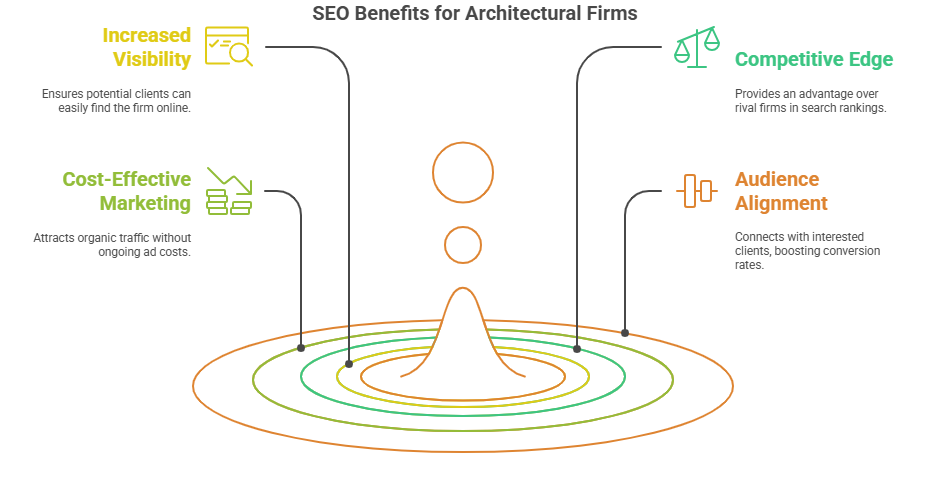
Search engine optimization involves various techniques aimed at increasing your website’s visibility on Google and other search engines. Here’s why it’s critical:
- Increased Visibility
Imagine a potential client typing “residential architects near me” into Google. Without SEO, your firm is unlikely to appear at the top of the results, meaning you miss out on potential opportunities. - Competitive Edge
Architecture is a competitive industry. A well-executed SEO strategy gives you an edge over firms that haven’t optimized their digital presence. - Cost-Effective Marketing
Unlike paid ads, SEO focuses on organic traffic, providing long-term results without the recurring expense of ad campaigns. - Audience Alignment
SEO ensures that the people finding your website are already interested in what you offer, increasing the likelihood of conversions.
Key Benefits of SEO for Architectural Firms
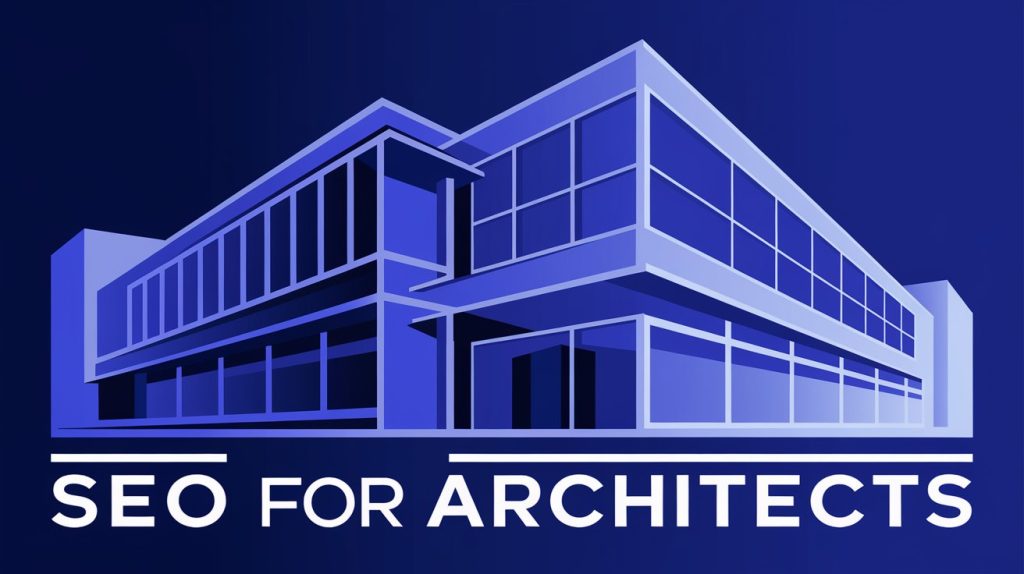
Attracting the Right Clients
Architectural projects often involve significant investments, so it’s essential to connect with clients who align with your expertise. SEO helps by targeting keywords and phrases specific to your services, such as “luxury residential architects” or “sustainable building design.” By optimizing for these search terms, your firm attracts clients who are actively searching for those services.
Enhancing Local Visibility
Most architectural firms serve clients within a specific geographical area. Local SEO strategies ensure your firm is visible in local searches. When potential clients search for “architects near me,” having an optimized Google Business Profile and localized content increases your chances of appearing in the coveted local 3-pack.
Building Brand Credibility and Authority
For architectural firms, showcasing expertise and reliability is paramount. Clients often look for firms with a strong portfolio and a credible reputation. SEO can position your firm as an authority by boosting content visibility and ensuring you rank high for relevant searches.
Setting the Foundation: Keyword Research for Architectural Firms
Keyword research means identifying the terms potential clients are typing into search engines when seeking architectural services. These keywords not only help you attract visitors but also ensure you’re connecting with the right audiencepeople looking for expertise in architecture, design, or related specialties.
What Are Keywords and Why Are They Important?
Keywords are the words and phrases users enter into search engines to find information. Keywords could range from broad terms like “architectural services” to more niche phrases like “modern sustainable home designs” or “commercial building architects in [City].”
Keywords are crucial because they:
- Drive Targeted Traffic: By aligning your website content with specific keywords, you attract users who are actively looking for your services.
- Enhance Visibility: Properly optimized keywords help your site rank higher in search engine results, increasing your chances of being discovered by prospective clients.
- Build Credibility: Appearing in searches for relevant queries establishes your firm as a knowledgeable and trustworthy resource.
- Support Local SEO: For firms serving specific regions, keywords such as “architects in [City]” improve your visibility within local markets.
Focusing on a mix of high-volume and long-tail keywords ensures a steady stream of visitors while targeting niche audiences with high intent.
Tools for Effective Keyword Research
Choosing the right tools for keyword research can make the process seamless and highly effective. Below are some industry-leading options tailored to suit architectural firms’ needs.
Google Keyword Planner
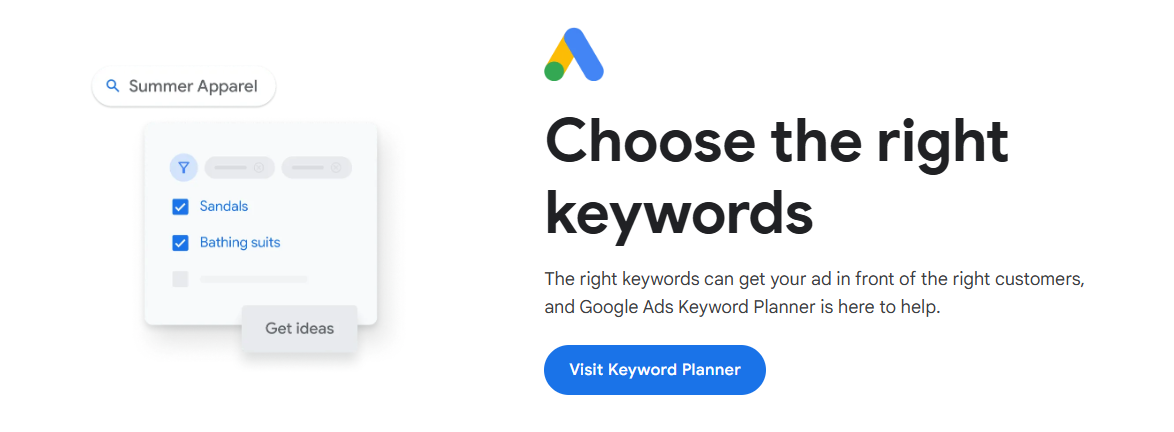 Google Keyword Planner is a free and reliable tool that provides insights into search volume, competition, and keyword variations. It’s particularly useful for:
Google Keyword Planner is a free and reliable tool that provides insights into search volume, competition, and keyword variations. It’s particularly useful for:
- Finding Broad and Niche Keywords: For instance, you can explore terms like “residential architects” or “green building design.”
- Analyzing Trends: See how keyword popularity fluctuates throughout the year. For example, “holiday home architecture” may peak during specific seasons.
- Estimating Competition: Understand which keywords are easier to rank for versus those that may require a larger effort.
To use it effectively:
- Enter general terms like “architectural design services” or “architectural firms near me.”
- Review the list of suggested keywords and refine your search by location, language, or industry.
- Filter for long-tail keywords that signal buyer intent, such as “award-winning architecture firms in [City].”
SEMrush and Ahrefs
These premium tools provide comprehensive data for more advanced keyword strategies. Both are invaluable for architectural firms aiming to dominate their niche.
- SEMrush:
- Offers keyword ideas, competitive analysis, and organic traffic insights.
- Allows you to study your competitors’ strategiessee which keywords drive traffic to their websites.
- Helps uncover long-tail keywords with low competition but high intent, such as “custom modern home designs [City].”
- Ahrefs:
- Renowned for its robust backlink analysis and keyword explorer features.
- Enables you to identify content gapskeywords your competitors rank for but you don’t.
- Provides detailed insights into search difficulty, helping you prioritize realistic goals like targeting terms such as “commercial building architects in [State].”
Both tools offer keyword difficulty scores, search volume metrics, and related keyword suggestions, empowering you to craft a comprehensive SEO strategy.
Targeting Long-Tail Keywords for Niche Clients
Long-tail keywords are specific, often detailed phrases that target niche audiences. They can be the key to attracting highly qualified leads. Examples might include:
- “Eco-friendly commercial building designs in [City]”
- “Luxury minimalist home architecture ideas”
- “Industrial loft renovation architects near me”
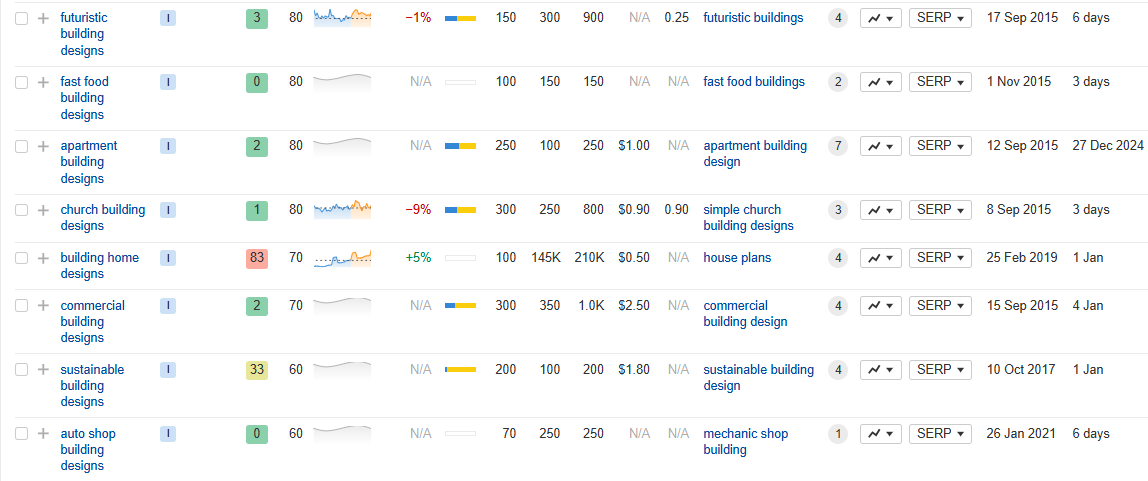
Long-Tail Keywords containing ‘Building Designs’ in ahrefs
Long-tail keywords are valuable because:
- They have less competition, making it easier to rank.
- They reflect buyer intent, capturing users closer to making a hiring decision.
- They cater to specialized needs, helping you stand out in niche markets.
To find effective long-tail keywords:
- Use SEMrush or Google Keyword Planner to identify phrases with moderate search volume and low competition.
- Incorporate client-focused terms like “best,” “affordable,” or “award-winning.”
- Analyze inquiries your firm frequently receives to identify patterns and keyword opportunities.
Targeting Location-Specific Keywords
For architectural firms, local visibility is critical. Targeting location-specific keywords ensures your website appears in searches for nearby services. Examples include:
- “Architectural firms in [City/Neighborhood]”
- “Best architects for modern homes in [State]”
- “Commercial architecture experts near [Landmark]”

Location-specific keywords for architectural firms
Here’s how to effectively target location-specific keywords:
- Include Locations in Your Content: Optimize service pages, blog posts, and meta descriptions with geographic modifiers.
- Leverage Google My Business: Add relevant keywords to your business listing to enhance local search visibility.
- Create Location-Specific Landing Pages: Showcase your expertise in different regions, tailoring content to highlight local projects and regulations.
- Use Regional Trends: Research popular architectural styles or trends in your target area to create compelling content.
Analyzing Your Competition for Keyword Ideas
Competitor analysis is a treasure trove of keyword inspiration. By studying successful architectural websites, you can uncover keyword opportunities and gaps in your own strategy.
Steps to analyze competitors:
- Identify Top Competitors: Use Ahrefs or SEMrush to find websites that rank well for your industry keywords.
- Audit Their Content: Analyze blog topics, service pages, and case studies for recurring keyword patterns.
- Check Keyword Rankings: Identify which terms drive traffic to their site and assess whether you can compete.
- Spot Content Gaps: Look for keywords they rank for but aren’t targeting effectively, and create high-quality content to fill those gaps.
Example: If a competitor ranks for “modern farmhouse designs,” you could differentiate yourself by targeting “sustainable modern farmhouse architecture.”
How to Align Keywords with Search Intent
Search intent refers to the reason behind a user’s query. Aligning keywords with intent ensures your content addresses potential clients’ needs, whether they’re researching, comparing, or ready to hire.
Types of search intent and examples:
- Informational: Keywords like “what makes a great architectural design” or “trends in sustainable architecture.”
- Ideal for blog posts and guides.
- Navigational: Queries like “top architectural firms in [City]” or “XYZ Architects portfolio.”
- Optimize your homepage, portfolio, and About Us pages.
- Transactional: Keywords like “hire an architect for home renovation” or “affordable architectural design services.”
- Focus on service pages and CTAs.
Match your content to user intent by:
- Conducting keyword research to identify intent-based variations.
- Structuring content to guide users through their decision-making journey.
- Incorporating clear, action-oriented language for transactional keywords.
Common Keyword Research Mistakes to Avoid
Keyword research requires careful planning and execution. Avoid these common pitfalls to ensure your strategy delivers results:
Overlooking Local Keywords
Failing to include local modifiers can result in lost opportunities to connect with nearby clients. Ensure your content features terms like “architects near [City]” and optimize your Google My Business profile.
Targeting Overly Competitive Phrases
Keywords with high search volume often have fierce competition. For example, “architectural design services” may be difficult to rank for, especially for smaller firms. Instead, focus on specific, less competitive phrases like “custom home designs in [City].”
Ignoring Search Volume and Trends
Low-volume keywords may not drive meaningful traffic, while ignoring seasonal trends can leave you unprepared for spikes in demand. Use Google Trends to track keyword performance and adjust your strategy accordingly.
Building an SEO-Friendly Website for Architects
Creating a website that is optimized for search engines is critical for architects looking to enhance their online presence and attract more clients. An SEO-friendly website not only ranks higher in search engine results but also provides an excellent user experience, converting visitors into leads. Below are the key aspects to focus on when building or optimizing your architectural website for SEO.
Website Design and User Experience for SEO
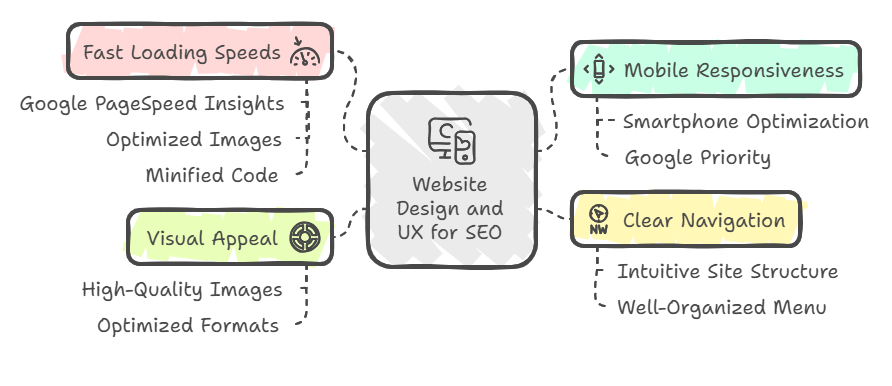
Website design and user experience (UX) are foundational to your SEO strategy. Search engines prioritize sites that provide a seamless and engaging experience for visitors. Your website should reflect your design expertise while also being functional and easy to navigate.
Key UX Principles for SEO:
- Mobile Responsiveness: Ensure your site is fully optimized for mobile users. Many clients search for services on their smartphones, and Google prioritizes mobile-friendly websites.
- Fast Loading Speeds: Use Google PageSpeed Insights to identify and fix issues that slow your site. Optimized images, minified code, and a reliable hosting service can significantly boost loading times.
- Clear Navigation: Use an intuitive site structure with a well-organized menu, allowing users to easily access information about services, portfolios, and contact details.
- Visual Appeal: Since architecture is a visual field, incorporate high-quality images and videos. Use optimized formats (like WebP) to balance quality and speed.
Essential On-Page SEO Factors
On-page SEO ensures that each page on your site is optimized for search engines and visitors alike. Here are the most critical factors to address:
Optimizing Page Titles and Meta Descriptions
Your page titles and meta descriptions are often the first things users see in search results. They should be concise, compelling, and keyword-optimized.
- Page Titles: Include primary keywords and keep the title under 60 characters. For example, “Award-Winning Architects in [City] | [Firm Name].”
- Meta Descriptions: Write a short summary (under 160 characters) that highlights the page’s value proposition and includes a call to action. Example: “Explore our innovative residential and commercial architecture services in [City]. Contact us today for a consultation.”
Creating SEO-Friendly URLs
Your URLs should be short, descriptive, and include your target keywords. Avoid using long strings of numbers or irrelevant characters.
- Bad URL: www.architectsfirm.com/page12345
- Good URL: www.architectsfirm.com/residential-architecture-services
This makes your content more readable for both users and search engines while improving click-through rates.
Adding Internal and Outbound Links
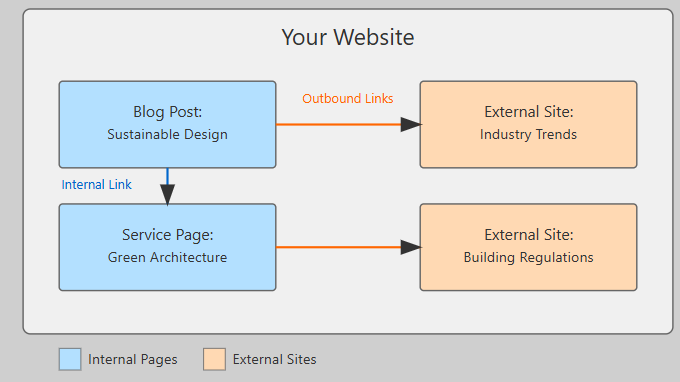
Links help search engines understand the structure of your website and build context around your content.
- Internal Links: Link to related pages on your site to guide visitors and improve crawlability. For example, link from a blog post about sustainable design to your service page for green architecture.
- Outbound Links: Reference credible, authoritative sources when discussing trends, materials, or regulations. This adds depth to your content and builds trust with readers.
Using Schema Markup for Rich Results
Schema markup is a type of code that helps search engines understand your content better. It’s especially useful for architects to highlight key aspects of their work, such as projects, awards, and services.
- Benefits of Schema Markup:
- Displays rich snippets like ratings, project images, or client reviews in search results.
- Increases click-through rates by making your listing stand out.
For example, use LocalBusiness Schema to showcase your office location and operating hours or Portfolio Schema to highlight specific projects.
Translating Content for Multinational Firms
If your firm operates in multiple countries, translating your content and optimizing it for multilingual SEO is crucial.
- Implement hreflang Tags: This helps search engines serve the correct language version of your website to users based on their location.
- Adapt Keywords: Research keywords in each target language and culture, ensuring they resonate with local audiences. For example, “architects in London” may be translated and optimized differently for UK English versus American English.
- Create Localized Content: Go beyond simple translations by tailoring your content to reflect regional architecture trends, regulations, and design preferences.
Optimizing Visuals for Architectural Firms Websites
For architects, visuals are the heart of showcasing your work and impressing potential clients. However, simply adding stunning images to your website isn’t enough. Proper optimization ensures that visuals enhance user experience and contribute to your SEO efforts without compromising site performance.
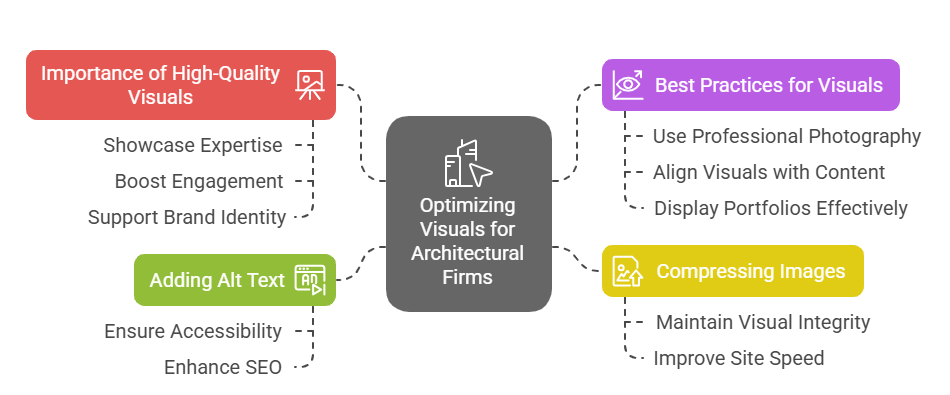
Importance of High-Quality Visuals
High-quality visuals are critical for creating a professional and engaging website. They:
- Showcase Expertise: Crisp, detailed images of your architectural projects communicate your skill and design vision.
- Boost Engagement: Eye-catching visuals keep visitors on your site longer, reducing bounce ratesa factor that impacts SEO rankings.
- Support Brand Identity: Consistently styled visuals reinforce your firm’s brand, making it memorable.
Best Practices for High-Quality Visuals:
- Use professional photography or 3D renderings to highlight unique aspects of your designs.
- Choose visuals that align with the page’s content, such as images of residential designs for a “Home Architecture” page.
- Display project portfolios in a visually appealing format, like sliders or galleries.
Compressing Images for Speed Without Losing Quality
Large image files can significantly slow down your website, harming both user experience and search rankings. Compressing images reduces file size while maintaining visual integrity.
Tools for Compression:
- Online Tools: Use tools like TinyPNG, JPEG Optimizer, or ImageOptim to reduce file sizes.
- Plugins: For CMS platforms like WordPress, plugins like WP Smush or ShortPixel can automate compression.
Key Tips:
- Choose the Right File Format:
- Use JPEG for photographs to balance quality and file size.
- Use PNG for images with transparent backgrounds or intricate details.
- Use WebP for modern, lightweight images with high quality.
- Resize Images Appropriately: Avoid uploading images larger than required. For example, scale portfolio images to fit your website layout without unnecessary resolution.
- Enable Lazy Loading: Load images only as users scroll down the page, improving initial load times.
Adding Alt Text to Images for Accessibility and SEO
Alt text (alternative text) serves two purposes: making your website accessible to visually impaired users and helping search engines understand image content.
Why Alt Text Matters:
- Accessibility: Screen readers use alt text to describe images, ensuring all users can access your content.
- SEO Benefits: Search engines use alt text to index images, allowing them to appear in image search results.
Best Practices for Writing Alt Text:
- Be descriptive but concise, e.g., “Modern minimalist kitchen designed by [Your Firm Name].”
- Include primary keywords naturally, but avoid keyword stuffing.
- Avoid generic descriptions like “image of a building” that don’t provide value.
Example: For an image of a sustainable residential project:
- Bad: “House image”
- Good: “Sustainable residential design with solar panels by [Firm Name] in [City].”
Mobile-Friendly and Adaptive Design
With the majority of users browsing on mobile devices, ensuring your website is critical for both user satisfaction and SEO performance.
What Is Mobile-Friendly Design? A mobile-friendly site adapts seamlessly to different screen sizes and devices, providing a consistent experience for users.
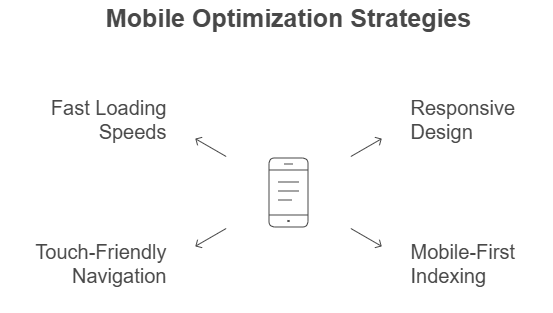
Key Elements of Mobile Optimization:
- Responsive Design: Use responsive web design to adjust layout, font sizes, and images for various devices.
- Mobile-First Indexing: Since Google predominantly uses the mobile version of websites for ranking, ensure your mobile site is fully optimized with no missing content.
- Touch-Friendly Navigation: Optimize menus, buttons, and forms for easy interaction on smaller screens.
- Fast Loading Speeds: Compress images, minimize code, and use Content Delivery Networks (CDNs) to improve loading times on mobile.
Tools for Testing Mobile-Friendliness:
- Use Chrome browser’s Inspect Mode and different devices to identify and fix issues.
- Analyze your website with GTmetrix or PageSpeed Insights for speed and usability improvements.
Local SEO Strategies for Architectural Firms
Local SEO is a powerful way to connect with nearby clients and establish a strong presence in their target regions. By focusing on local strategies, you can enhance your visibility in search results and attract clients actively seeking architectural services in your area.
Setting Up and Optimizing Your Google My Business Profile
Google My Business (GMB) is a critical tool for local SEO. A well-optimized GMB profile improves your chances of appearing in Google’s Local Pack, Google Maps, and localized search results.
Steps to Optimize Your GMB Profile:
- Claim and Verify Your Profile:
- Visit Google My Business and claim your business.
- Complete the verification process by mail, phone, or email.
- Complete Your Business Information:
- Add accurate details such as your firm’s name, address, phone number (NAP), and website.
- Choose the most relevant business category, such as “Architect” or “Architectural Design Firm.”
- Add High-Quality Visuals:
- Showcase your projects with high-resolution images of completed designs, team photos, and office space.
- Update images regularly to keep your profile engaging.
- Encourage and Respond to Reviews:
- Ask satisfied clients to leave reviews on your GMB page.
- Respond to reviews promptly, whether positive or negative, to show that you value client feedback.
- Utilize GMB Features:
- Add posts about recent projects, blog articles, or special events.
- Include operating hours and appointment booking links to make it easier for clients to connect with you.
Local Keyword Research and Implementation
To rank for localized searches, it’s important to identify and target keywords that reflect your services and location.
Implementing Local Keywords:
- Service Pages: Optimize your service-specific pages with local keywords. For example, use “Modern office design in [City]” on your commercial architecture page.
- Blog Content: Create posts around local topics, such as “Top Architectural Trends in [City]” or “Building Regulations for Residential Homes in [State].”
- Meta Tags: Include local keywords in your title tags, meta descriptions, and headers for every page.
- Image Alt Text: Use location-based descriptions in your image alt text, such as “Minimalist kitchen design in [City] by [Firm Name].”
Building Local Citations and Directories
Citations are online mentions of your architectural firm’s name, address, and phone number (NAP). Consistent citations across the web improve your local SEO rankings by validating your business information.
Where to Build Local Citations:
- Online Directories:
- Submit your firm to reputable directories like Yelp, Houzz, ArchitectsUSA, and Angie’s List.
- Use industry-specific directories for added authority.
- Local Business Listings:
- Register with local chamber of commerce websites, city business directories, and community boards.
- Ensure your NAP details are consistent with your GMB profile.
- Professional Associations:
- Get listed with organizations like the American Institute of Architects (AIA) or regional architecture groups.
Best Practices for Building Citations:
- Ensure Consistency: Your NAP details should match exactly across all platforms.
- Use Structured and Unstructured Citations:
- Structured citations appear in formatted directories (e.g., Yelp or Google).
- Unstructured citations appear in articles, blogs, or social media mentions.
- Monitor and Update Listings: Use SEO tools like Moz Local or BrightLocal to find and fix inconsistent citations.
Collecting and Showcasing Client Reviews
Client reviews play a pivotal role in local SEO, as they help build trust and influence potential clients while signaling credibility to search engines. High-quality reviews also boost your chances of appearing in Google’s Local Pack.
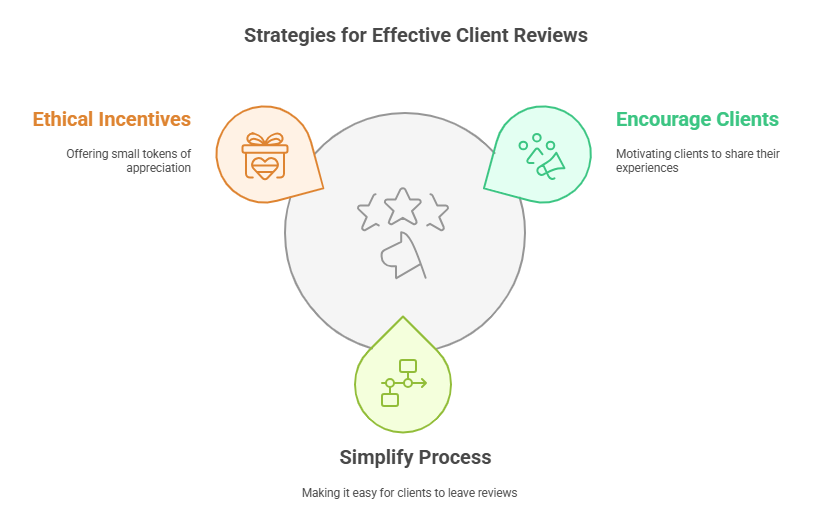
How to Collect Client Reviews:
- Encourage Satisfied Clients to Leave Reviews:
- After completing a project, send a polite request for feedback via email, including links to your Google My Business (GMB) profile or other review platforms like Yelp or Houzz.
- Make the Process Simple:
- Provide clear instructions and direct links to where they can leave reviews.
- Create a QR code for clients to scan and access your review page instantly.
- Incentivize Reviews (Ethically):
- Offer small tokens of appreciation, such as branded merchandise, as a thank-you for leaving a review (without directly asking for positive reviews).
Showcasing Reviews:
- On Your Website:
- Add a “Client Testimonials” section with quotes, ratings, and project images to highlight the quality of your work.
- Social Media:
- Share positive reviews on platforms like Instagram or LinkedIn to showcase happy clients and build credibility.
- Google My Business:
- Feature reviews prominently in your GMB profile, as these appear in search results and can influence decision-making.
SEO Benefits of Reviews:
- Reviews contribute to local ranking factors in Google’s algorithm.
- Keywords within reviews (e.g., “modern home design in [City]”) can boost relevance for local searches.
Leveraging Local Content Marketing
Creating locally focused content is an effective way to connect with your target audience and improve local SEO. By addressing topics of regional interest, you can drive organic traffic while establishing yourself as an authority in your area.
Ideas for Local Content:
- Highlight Local Projects:
- Write case studies or blog posts about projects you’ve completed in the area. For example: “Transforming a Historic [City] Home: A Modern Twist on Tradition.”
- Focus on Local Trends:
- Cover architectural trends specific to your location, such as “Sustainable Architecture in [City]” or “Top Designs for Coastal Homes in [State].”
- Address Local Pain Points:
- Create content around challenges your clients face, such as zoning laws, building regulations, or extreme weather conditions.
- Collaborate with Local Partners:
- Partner with contractors, interior designers, or local suppliers to create co-branded content or guest posts.
Content Formats:
- Blog posts, videos, and infographics tailored to your local audience.
- “How-to” guides, such as “Navigating [City’s] Building Permit Process.”
- Community-oriented content, such as upcoming events or local architecture showcases.
Local Content SEO Tips:
- Use geo-specific keywords naturally throughout your content.
- Add internal links to your service pages.
- Share content on local forums, social media groups, or neighborhood platforms to reach your community.
The Role of the “Local 3-Pack” in Google Search Results
The Local 3-Pack refers to the top three local businesses displayed in Google’s local search results, along with a map snippet. Appearing in the Local 3-Pack can significantly boost visibility and clicks.
Why the Local 3-Pack Matters:
- It dominates prime real estate in search results, often appearing above organic listings.
- It showcases essential information like your business name, reviews, location, and operating hours, helping clients quickly assess your firm.
How to Get Featured in the Local 3-Pack:
- Optimize Your Google My Business Profile:
- Ensure all information is complete, accurate, and consistent with your website.
- Use location-based keywords in your business description.
- Focus on Reviews:
- Accumulate a high volume of positive reviews on Google. Respond to each review to show engagement.
- Build Local Backlinks:
- Earn links from local organizations, blogs, and media outlets to improve your local authority.
- Ensure NAP Consistency:
- Keep your business name, address, and phone number consistent across your website, GMB profile, and citations.
- Leverage Proximity:
- Be specific about your service area, as Google uses proximity as a ranking factor.
Tracking Local 3-Pack Performance:
- Use BrightLocal or Moz Local to monitor your local rankings and visibility.
- Track search queries and impressions in your Google My Business insights.
Content Marketing for Architectural Firms
Content marketing is a powerful tool to establish authority, connect with their target audience, and improve their SEO performance. By creating high-quality, engaging content, architects can not only showcase their expertise but also attract and convert potential clients.
The Role of Content in Building Authority
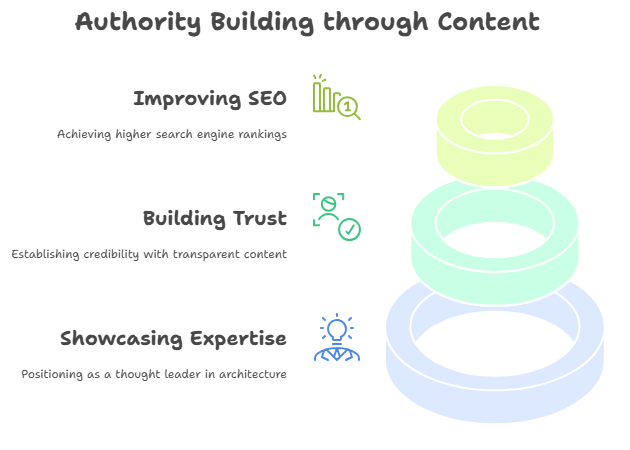
For architects, authority is critical. Potential clients want to work with firms that are knowledgeable, experienced, and trustworthy. Content plays a significant role in demonstrating these qualities by:
- Showcasing Expertise:
- Well-researched articles and insights into industry trends position your firm as a thought leader.
- Sharing unique architectural approaches or solutions adds depth to your reputation.
- Building Trust:
- Transparent and valuable content, such as case studies or client testimonials, helps establish credibility.
- Consistent, high-quality publishing reassures audiences of your reliability.
- Improving SEO:
- Search engines favor authoritative content, rewarding it with higher rankings.
- Content with targeted keywords and valuable information improves visibility and attracts organic traffic.
Types of Content for Architects
Diverse content types allow architectural firms to reach different segments of their audience while highlighting various aspects of their expertise. Below are the most impactful types of content:
Blogs
Blogs are the cornerstone of content marketing. They allow you to address client pain points, share industry knowledge, and improve keyword targeting.
Example Topics:
- “Top 5 Trends in Sustainable Architecture for [Year].”
- “How to Choose the Right Architect for Your Commercial Project.”
- “Understanding Zoning Laws for Residential Projects in [City].”
SEO Tip: Use long-tail keywords like “modern eco-friendly home designs in [City]” to target niche audiences.
Case Studies
Case studies provide detailed insights into your completed projects, highlighting your problem-solving abilities and success stories.
What to Include:
- Client goals and challenges.
- Your approach and the solutions provided.
- Before-and-after visuals or project renderings.
Example: “Transforming a Historic Building in [City] into a Modern Office Space.”
SEO Tip: Incorporate location-based keywords and industry terms to optimize for local and specific searches.
Videos
Videos are a compelling way to engage your audience and showcase your work visually. They’re particularly effective for architects because they highlight design details, project walkthroughs, and construction processes.
Ideas for Video Content:
- Virtual tours of completed projects.
- Time-lapse videos of a design coming to life.
- Behind-the-scenes content showcasing your team’s workflow.
SEO Tip: Host your videos on YouTube and embed them on your website, using keyword-rich titles and descriptions.
Podcasts
Podcasts offer a unique platform to share industry insights, interview thought leaders, and discuss architectural trends.
Topics to Explore:
- Challenges in sustainable architecture.
- Innovations in urban design.
- Interviews with satisfied clients or collaborators.
SEO Tip: Optimize podcast descriptions and titles with relevant keywords to improve discoverability.
Infographics
Infographics present complex information in an easy-to-digest visual format. They’re highly shareable, which can increase backlinks and social media visibility.
Infographic Ideas:
- Step-by-step processes for building design and approvals.
- Data on architectural trends or materials.
- Visual guides for zoning laws or project planning.
SEO Tip: Use optimized image file names and alt text to help search engines index your infographics.
How to Demonstrate E-A-T (Expertise, Authority, and Trustworthiness)
E-A-T (Expertise, Authority, and Trustworthiness) is a critical framework for creating content that resonates with both audiences and search engines. Here’s how architectural firms can demonstrate E-A-T effectively:
- Expertise:
- Publish detailed guides, whitepapers, and thought leadership articles.
- Highlight team credentials, awards, certifications, and memberships (e.g., AIA accreditation).
- Authority:
- Showcase your portfolio and provide data-backed insights.
- Earn backlinks from reputable industry websites, publications, and blogs.
- Share case studies and client testimonials to reinforce your reputation.
- Trustworthiness:
- Display client reviews prominently on your website.
- Ensure your site has strong technical SEO, including HTTPS for security.
- Provide transparent information about your process, pricing, and timelines.
SEO Tip: Regularly update your content to ensure it remains accurate and relevant, reinforcing your position as a reliable source of information.
Creating Hyper-Localized Content
Hyper-localized content focuses on specific regions, cities, or neighborhoods to target audiences searching for architectural services in their area. For architects, this strategy is key for connecting with local clients and improving search visibility.
Benefits of Hyper-Localized Content:
- Improves Local SEO: Search engines prioritize content tailored to a specific location.
- Attracts Niche Audiences: Engages clients with an immediate need for services in a defined area.
- Showcases Regional Expertise: Highlights your knowledge of local architectural styles, zoning laws, and materials.
Ideas for Hyper-Localized Content:
- Neighborhood Spotlights:
- Write about design trends specific to neighborhoods, e.g., “Modern Loft Conversions in [Neighborhood Name].”
- Project Features:
- Highlight completed projects in specific areas, e.g., “Transforming [City]’s Historic Buildings into Modern Spaces.”
- Local Guides:
- Offer guides on regional regulations or processes, such as “Understanding Building Permits in [City].”
Tips for Implementation:
- Use local keywords in titles, headings, and throughout the content.
- Include high-quality images of projects tied to the location.
- Embed maps and links to local landmarks for added relevance.
Blogging for Architects: Best Practices
A well-maintained blog can drive traffic, improve SEO, and position your firm as an authority. However, success requires strategic planning and execution.
Key Practices for Blogging:
- Focus on Audience Needs:
- Address common questions and concerns. Example: “What to Consider When Hiring an Architect for Your Home Renovation.”
- Provide educational content like “Top Architectural Trends of [Year].”
- Incorporate SEO Best Practices:
- Use long-tail keywords naturally, such as “eco-friendly home designs in [City].”
- Optimize meta descriptions, headings, and image alt text for search engines.
- Use internal links to guide readers to service pages or portfolio sections.
- Maintain a Professional yet Relatable Tone:
- Balance technical insights with accessible language to appeal to both industry peers and clients.
- Leverage Visuals:
- Enrich posts with project images, diagrams, and infographics to keep readers engaged.
- Promote Your Blog:
- Share posts on social media, email newsletters, and local forums to increase visibility.
Blog Topic Ideas:
- “10 Must-Know Building Codes for Residential Projects in [City].”
- “How Sustainable Architecture Can Save You Money.”
- “Step-by-Step Guide to Designing Your Dream Home.”
Maintaining Consistency in Content Publishing
Consistency is a cornerstone of successful content marketing for architects. Regular publishing helps maintain audience engagement, improve SEO rankings, and establish authority.
Why Consistency Matters:
- Improves SEO Performance: Search engines favor websites that publish fresh, relevant content regularly.
- Builds Audience Trust: Clients are more likely to engage with a firm that consistently provides valuable insights.
- Strengthens Brand Awareness: Frequent publishing keeps your firm top of mind for potential clients.
How to Stay Consistent:
- Develop a Content Calendar:
- Plan topics and publishing dates at least 1–3 months in advance.
- Include a mix of blog posts, case studies, videos, and social media updates.
- Set Realistic Goals:
- Start with a manageable frequency, such as one blog post per month, and scale up as resources allow.
- Repurpose Content:
- Turn a blog post into a video, podcast episode, or infographic to maximize its value.
- Assign Roles:
- Delegate tasks to team members or hire content specialists to ensure steady output.
Off-Page SEO Tactics for Architects
Off-page SEO is crucial for websites looking to enhance their authority, attract organic traffic, and improve search engine rankings. By building a strong presence beyond your website, you can establish trust and credibility in your industry while reaching a broader audience.
Building High-Quality Backlinks
Backlinks from reputable websites are one of the most effective ways to signal your architectural firm’s authority to search engines. Focus on acquiring links from sites that are relevant to your industry and audience.
Guest Blogging
Guest blogging involves contributing valuable content to other websites in exchange for a backlink. This strategy allows you to share your expertise while driving traffic to your site.
How to Get Started:
- Identify architecture-related blogs, construction platforms, or real estate websites that accept guest contributions.
- Pitch unique, insightful topics tailored to their audience, such as:
- “Sustainable Building Trends for [Year]”
- “The Architect’s Guide to Zoning Laws in [City]”
- Incorporate a link to your website in the article or author bio, leading readers to relevant pages like your portfolio or blog.

Identifying architecture-related websites for link building
Industry-Specific Directories
Listing your firm in trusted directories boosts visibility and provides high-quality backlinks.
Best Directories for Architects:
- Houzz: Highlight your portfolio and client reviews.
- ArchitectsUSA: Gain exposure within a professional network.
- AIA (American Institute of Architects): Build credibility and gain authoritative backlinks.
Tips:
- Ensure all business information (NAP: name, address, phone) is consistent across listings.
- Use keyword-optimized descriptions to enhance your local SEO.
Links from Professional Associations
Being featured on professional association websites provides authoritative backlinks and increases your credibility.
How to Earn Links:
- Join reputable organizations like the American Institute of Architects (AIA) or local architectural societies.
- Contribute content to their newsletters, blogs, or resource sections.
- Participate in events or competitions hosted by these organizations to gain mentions and backlinks.
Outreaching Your Competitors’ Link Donors
Analyzing competitors’ backlinks can help uncover untapped opportunities for your website.
How to Implement This Strategy:
- Use SEO software like Ahrefs or SEMrush to identify sites linking to competitors.
- Reach out to those websites with a value-driven pitch, offering unique content, case studies, or resources they might find beneficial.
- Focus on niche-specific platforms and high-authority websites to maximize impact.
Leveraging PR for Backlinks
Public relations (PR) is a powerful off-page SEO tool that can generate high-authority backlinks and boost your visibility in both local and industry-specific media.
Press Releases
Distributing press releases about noteworthy events or achievements can attract media coverage and backlinks.
Examples of Newsworthy Events:
- Winning a design award or competition.
- Completing a high-profile project or community initiative.
- Launching innovative architectural services or technology.
Tips for Effective Press Releases:
- Use platforms like PR Newswire or local media outlets to distribute your release.
- Include keyword-rich links to relevant pages on your website, such as your portfolio or contact page.
Newsjacking
Newsjacking involves leveraging trending stories to gain attention and backlinks by positioning yourself as an expert in the topic.
How to Execute Newsjacking:
- Monitor industry news and local developments using Google Alerts or BuzzSumo.
- Create timely content or provide expert commentary, such as:
- “How [New Regulation] Impacts Commercial Architecture in [City].”
- “The Role of Architects in [Current Trend].”
- Share your content with journalists or bloggers covering the topic, encouraging them to reference your insights with a backlink.
Social Media for SEO
Social media plays a crucial role in off-page SEO for architectural websites. While not a direct ranking factor, social platforms amplify your content, drive traffic to your site, and provide opportunities to build relationships that lead to backlinks and business growth.
Sharing Content to Drive Traffic
Sharing content on social media helps you engage with your audience and attract potential clients to your website.
Types of Content to Share:
- Project Spotlights:
- Share completed projects with high-quality images, including before-and-after transformations.
- Include links to your portfolio or project case studies for further exploration.
- Educational Content:
- Post blog links, infographics, or guides on topics like “Sustainable Architecture Trends for [Year].”
- Use visually engaging formats like carousel posts or videos to capture attention.
- Behind-the-Scenes Content:
- Showcase your design process, team, or on-site project progress to add a personal touch.
Best Practices:
- Use relevant hashtags, such as #ModernArchitecture, #GreenBuilding, or #[CityName]Architect.
- Post consistently to maintain visibility and engagement.
- Add strong calls-to-action (e.g., “Check out our full project portfolio: [link]”).
Building Relationships with Local Influencers
Collaborating with local influencers can enhance your social reach and build your brand’s credibility.
How to Identify Local Influencers:
- Look for individuals or businesses in related niches, such as real estate agents, interior designers, or construction experts.
- Search for local hashtags (e.g., #[CityName]Design) to find influencers within your community.
Collaboration Ideas:
- Project Spotlights:
- Invite influencers to tour and feature one of your completed architectural projects.
- Joint Content Creation:
- Partner on videos, blog posts, or live Q&A sessions about design trends or construction tips.
- Cross-Promotion:
- Share each other’s posts and tag one another to reach a wider audience.
SEO Benefits:
- Influencer content often drives traffic to your website.
- Mentions and backlinks from influencer blogs or social accounts improve your site’s authority.
Partnering with Local Businesses for Collaborative Opportunities
Partnering with local businesses is an excellent off-page SEO tactic that benefits both parties by fostering community relationships and generating backlinks.
Collaborative Opportunities with Local Businesses
- Co-Branded Content:
- Work with complementary businesses, such as contractors, interior designers, or real estate agencies, to create valuable content like:
- Guides: “How to Design and Build the Perfect Home in [City].”
- Blog series: Collaborative articles showcasing both businesses’ expertise.
- Include backlinks to each partner’s website in the content.
- Work with complementary businesses, such as contractors, interior designers, or real estate agencies, to create valuable content like:
- Joint Events:
- Host events like design workshops, home tours, or community meetups with local partners.
- Promote the events through each partner’s website, generating backlinks and driving traffic.
- Sponsor Local Initiatives:
- Support or sponsor local events, charities, or educational programs. For example:
- Donate design expertise for a community project.
- Sponsor a “Green Building Awareness” campaign in your city.
- Sponsorships often result in mentions and backlinks from the event’s promotional materials.
- Support or sponsor local events, charities, or educational programs. For example:
SEO Benefits of Local Partnerships
- Backlinks from trusted local businesses and organizations improve your site’s authority and relevance.
- Cross-promotion increases traffic to your website from new, targeted audiences.
- Collaborative content reinforces your position as a key player in the local architecture community.
Technical SEO for Architectural Websites
Technical SEO ensures that your architectural website is optimized for search engine crawlers and users, creating a solid foundation for higher rankings and improved visibility. Here’s a comprehensive guide to the critical technical SEO elements every architectural website should address.
Conducting a Technical Audit
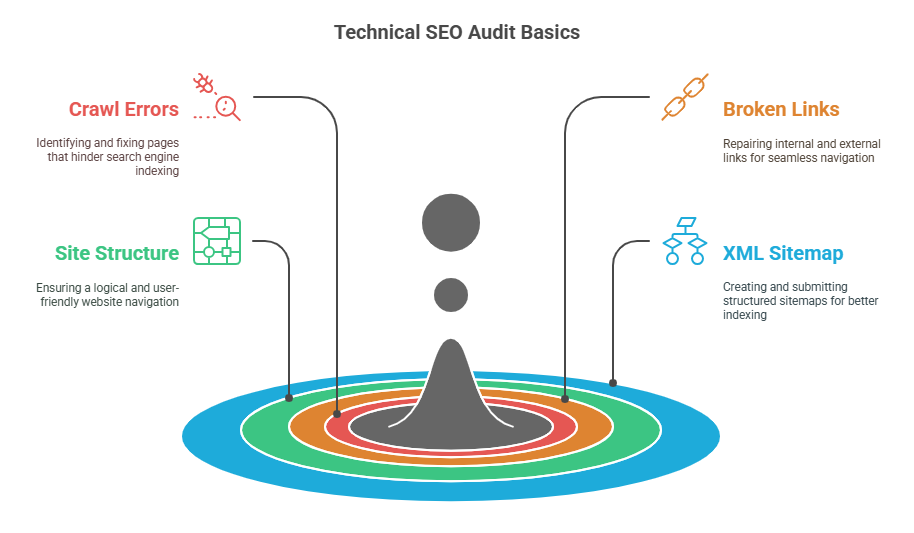
A technical audit is the first step to identifying and resolving issues that could hinder your website’s performance in search engines. Google Search Console, Screaming Frog, and SEMrush can help uncover potential issues.
Key Areas to Audit:
- Crawl Errors: Identify pages that search engines can’t crawl or index.
- Broken Links: Fix internal and external broken links to ensure seamless navigation.
- Site Structure: Ensure a logical structure with clear navigation for users and search engines.
- XML Sitemap: Create and submit a well-structured XML sitemap to Google and Bing to improve indexing.
Website Security (SSL Certificates)
Website security is a crucial ranking factor and user trust element. Having an SSL certificate ensures your site uses HTTPS, a secure protocol for transferring data.
Why SSL Matters:
- SEO Advantage: Google prioritizes HTTPS sites, improving your rankings.
- User Trust: Visitors feel safer browsing your site, especially when sharing sensitive information like contact forms.
How to Implement SSL:
- Purchase an SSL certificate from your hosting provider or a certificate authority.
- Configure your site to use HTTPS instead of HTTP.
- Update internal links and ensure redirects from HTTP to HTTPS are in place.
Indexing and Crawling Issues
Search engines must crawl and index your site effectively for it to rank. Common indexing issues can prevent important pages from appearing in search results.
How to Fix Indexing Issues:
- Use Robots.txt:
- Ensure critical pages aren’t accidentally blocked by your robots.txt file.
- Allow crawlers to access CSS and JavaScript files for proper rendering.
- Check Noindex Tags:
- Review pages for unnecessary noindex tags that prevent them from being indexed.
- Fix 404 Errors:
- Redirect 404 pages to relevant content or your homepage to retain link equity.
Tool Tip: Use Google Search Console’s Coverage Report to monitor indexing errors and address them promptly.
Fixing Duplicate Content
Duplicate content can confuse search engines and dilute your rankings. Duplicate content often occurs on service pages targeting multiple locations or portfolio entries.
Solutions for Duplicate Content:
- Canonical Tags:
- Use canonical tags to point search engines to the preferred version of duplicate pages.
- Merge Content:
- Combine similar pages into one authoritative page to improve content quality and focus.
- Rewrite Content:
- Create unique content for location-based service pages, focusing on regional relevance and specific client needs.
Improving Website Speed
Page speed is a critical ranking factor and has a direct impact on user experience. Slow websites increase bounce rates, reducing your chances of converting visitors into clients.
How to Improve Speed:
- Optimize Images:
- Compress images.
- Use modern formats like WebP for faster load times.
- Minify Code:
- Remove unnecessary characters, spaces, and comments from HTML, CSS, and JavaScript files.
- Enable Browser Caching:
- Store static resources locally on users’ devices to reduce load times for repeat visitors.
- Use a Content Delivery Network (CDN):
- Distribute your content across multiple servers worldwide to improve load times for global users.
Tool Tip: Analyze speed with Google PageSpeed Insights or GTmetrix and implement recommended optimizations.
Enhancing Mobile Usability
With mobile devices accounting for a significant portion of web traffic, ensuring your site is mobile-friendly is vital for both SEO and user satisfaction.
How to Optimize Mobile Usability:
- Responsive Design:
- Use responsive web design to adapt your site layout and content to various screen sizes.
- Mobile Navigation:
- Simplify menus and ensure buttons and links are easy to click on smaller screens.
- Eliminate Intrusive Elements:
- Avoid pop-ups or interstitials that obstruct content on mobile devices.
Optimizing Website Code for Performance
Optimizing your website’s code is crucial for improving its speed, usability, and overall SEO performance. This ensures that potential clients have a smooth and enjoyable browsing experience, which helps increase engagement and conversions.
Key Strategies to Optimize Website Code:
- Minify HTML, CSS, and JavaScript:
- Remove unnecessary characters, spaces, and comments from your website’s code.
- Tools like Minify Code or UglifyJS can automate this process.
- Result: Faster loading times and reduced file sizes.
- Enable Lazy Loading:
- Delay the loading of images and videos until they are needed (e.g., when a user scrolls to them).
- This reduces initial page load times, especially for image-heavy architectural portfolios.
- Use Asynchronous Loading for JavaScript:
- Allow JavaScript files to load independently, preventing them from blocking the rendering of the page.
- Implement the async or defer attribute in your script tags.
- Implement Server-Side Rendering (SSR):
- For dynamic architectural websites, SSR can help load content faster and ensure search engines can crawl the content effectively.
- Reduce HTTP Requests:
- Combine multiple CSS or JavaScript files into a single file to reduce the number of server requests.
- Use sprite sheets for frequently used images like icons.
Using XML Sitemaps and Robots.txt Files
XML sitemaps and robots.txt files are critical tools for ensuring search engines can crawl and index your architectural website efficiently.
XML Sitemaps
An XML sitemap provides a structured list of your website’s pages, helping search engines understand its layout and prioritize important content.
How to Use XML Sitemaps:
- Generate a Sitemap:
- Use plugins like Yoast SEO (for WordPress) or online sitemap generators to create an XML sitemap.
- Include Key Pages:
- Ensure your sitemap highlights critical pages like service descriptions, portfolio entries, and blog posts.
- Submit to Search Engines:
- Upload your sitemap to Google Search Console and Bing Webmaster Tools for faster indexing.
Tip: Regularly update your sitemap to reflect changes in your site structure, such as new blog posts or projects.
Robots.txt Files
A robots.txt file directs search engine crawlers on how to navigate your site, specifying which pages or files should be indexed or ignored.
How to Optimize Robots.txt:
- Allow Critical Pages:
- Ensure search engines can crawl key sections like your portfolio, service pages, and blog.
- Test Your Robots.txt:
- Use the Robots.txt Tester in Google Search Console to ensure it works as intended.
- Block Irrelevant Pages:
- Exclude admin pages, staging areas, or duplicate content using Disallow.
Example:
Disallow: /wp-admin/
Tip: Avoid blocking JavaScript or CSS files, as search engines need access to them to render your pages properly.
Regular Maintenance and Updates
Regular maintenance ensures that your architectural website remains optimized, secure, and aligned with evolving SEO standards.
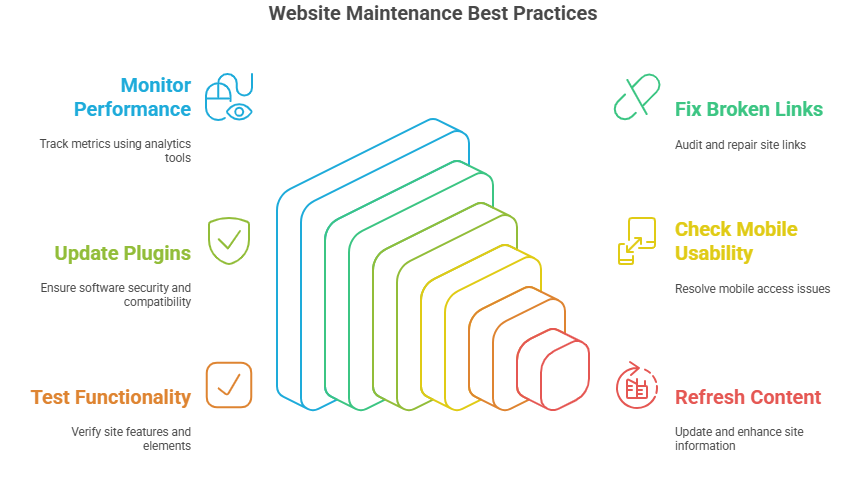
Why Maintenance Matters:
- Prevents technical issues like broken links or outdated content from harming your rankings.
- Adapts your site to search engine algorithm updates.
- Keeps user experience smooth and consistent.
Best Practices for Regular Maintenance:
- Monitor Website Performance:
- Use Google Analytics to track bounce rates, and traffic.
- Address any performance dips promptly.
- Fix Broken Links:
- Regularly audit your site for broken internal and external links using tools like Screaming Frog or Ahrefs.
- Redirect or replace broken links to maintain SEO value.
- Update Plugins and Themes:
- For CMS platforms like WordPress, keep plugins and themes updated to the latest versions to avoid vulnerabilities and compatibility issues.
- Check for Mobile Usability Issues:
- Use Google Search Console to identify and resolve mobile usability errors.
- Test Site Functionality:
- Regularly test forms, navigation menus, and interactive elements to ensure they work as intended.
- Refresh Content:
- Update old blog posts, portfolio pages, or service descriptions with new information, images, or insights to keep them relevant and rank-worthy.
Measuring and Analyzing SEO Success for Architectural Firms
To ensure your SEO efforts are paying off, consistent measurement and analysis are essential. By tracking key metrics, leveraging analytical tools, and refining your strategies, your architectural firm can continuously improve its online visibility and attract more qualified leads.
Essential SEO Metrics to Track
Understanding which metrics to monitor is crucial for evaluating the effectiveness of your SEO strategy. Here are the most important ones:
Organic Traffic
Organic traffic measures the number of visitors who arrive at your site through unpaid search results. It’s a direct indicator of your visibility on search engines.
- Why It Matters: Increased organic traffic means your website ranks higher for relevant keywords, attracting potential clients.
- How to Track:
- Use Google Analytics to view the “Acquisition > Channels > Organic Search” report.
- Analyze trends over time to understand growth patterns and seasonal changes.
Keyword Rankings
Tracking your website’s ranking for targeted keywords helps gauge how well your content is optimized.
- Why It Matters: Higher rankings for relevant keywords improve your visibility to potential clients.
- How to Track:
- Use SEMrush, Ahrefs, or Google Search Console to monitor keyword positions.
- Focus on high-intent keywords like “modern home architects in [City]” or “sustainable building design.”
Backlink Profile
Your backlink profile refers to the quantity and quality of websites linking to your content.
- Why It Matters: High-quality backlinks improve your site’s domain authority and trustworthiness in the eyes of search engines.
- How to Track:
- Use SEO tools like Ahrefs or Moz Link Explorer to monitor new and lost backlinks.
- Assess the relevance and domain authority of linking websites to ensure they align with your niche.
Using Tools for Analysis
Several tools can help you track and analyze your SEO performance, offering actionable insights to refine your strategy.
Google Analytics
Google Analytics provides a comprehensive view of your website’s traffic, audience behavior, and conversions.
Key Features:
- Track organic traffic sources and landing pages.
- Measure user engagement through metrics like bounce rate and average session duration.
- Analyze conversions to determine how SEO contributes to leads or inquiries.
Google Search Console
Google Search Console focuses on your site’s performance in search results and helps identify technical issues.
Key Features:
- Monitor keyword rankings and click-through rates (CTR) for specific queries.
- Identify indexing and crawl errors that could impact visibility.
- Analyze which pages receive the most impressions and clicks from organic search.
Paid SEO Tools (Ahrefs, SEMrush, Moz)
Premium tools offer advanced features for tracking, analyzing, and improving your SEO strategy.
Key Features:
- Ahrefs: Monitor backlinks, keyword rankings, and site health.
- SEMrush: Perform competitor analysis, keyword research, and site audits.
- Moz: Evaluate domain authority, keyword difficulty, and link-building opportunities.
Tip: Use these tools to identify content gaps, analyze competitors, and uncover new keyword opportunities.
Refining SEO Strategy Based on Analytics
Analyzing your data is only the first stepusing that data to improve your strategies is where the real growth happens.
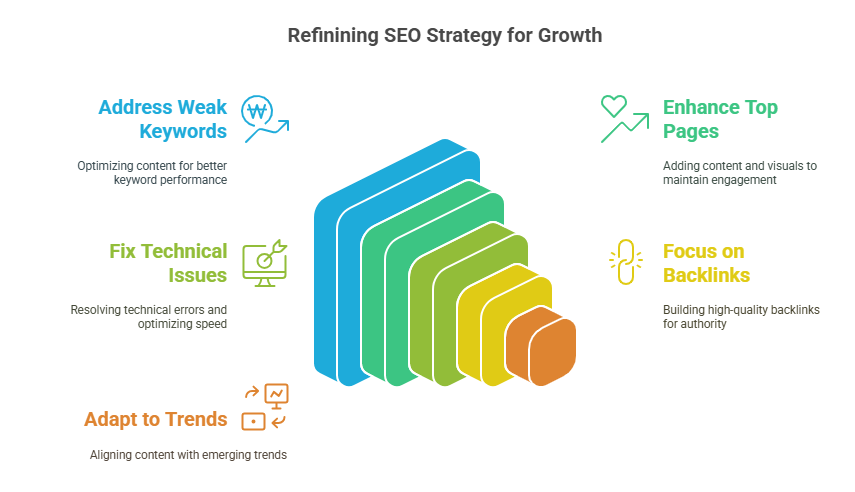
How to Refine Your SEO Strategy:
- Address Weak Performing Keywords:
- Identify keywords with low rankings or CTR in Google Search Console.
- Optimize existing content or create new, more targeted pages to boost rankings.
- Enhance Top-Performing Pages:
- Analyze pages driving the most organic traffic in Google Analytics.
- Add fresh content, visuals, or internal links to improve engagement and maintain rankings.
- Fix Technical Issues:
- Resolve errors flagged in Google Search Console, such as crawl issues or mobile usability problems.
- Optimize slow-loading pages identified in Google PageSpeed Insights.
- Focus on High-Quality Backlinks:
- Use tools like Ahrefs to identify low-quality or spammy backlinks and disavow them if necessary.
- Prioritize outreach for backlinks from reputable architecture blogs, directories, or professional organizations.
- Adapt to Trends:
- Monitor keyword trends in Google Trends.
- Align your content strategy with seasonal or industry-specific shifts, such as sustainability in architecture or regional building regulations.
Advanced SEO Strategies for Architectural Firms
To stay ahead in the competitive field of architecture, advanced SEO strategies can help your firm achieve sustained growth and visibility. These techniques go beyond basic optimization, leveraging cutting-edge tools and practices to drive targeted traffic and long-term success.
Leveraging AI for SEO Insights
Artificial Intelligence (AI) is revolutionizing SEO, offering powerful insights and automation capabilities that can enhance your strategy.
Applications of AI in SEO:
- Predictive Analytics:
- Tools like BrightEdge and SEMrush’s AI-driven insights can forecast keyword trends and traffic patterns, helping you target emerging opportunities.
- Content Optimization:
- Use AI-powered tools like Surfer SEO or Clearscope to analyze top-ranking pages and optimize your content for semantic relevance and user intent.
- Chatbots for Engagement:
- Deploy AI chatbots on your website to answer client questions, guide visitors to relevant content, and collect valuable user data.
- Automated Reporting:
- Simplify performance tracking with AI tools that generate actionable SEO reports, saving time and enhancing decision-making.
How to Start:
- Integrate AI-driven SEO tools into your workflow for competitive analysis, content generation, and keyword tracking.
- Use tools like MarketMuse to uncover content gaps and develop authoritative, data-backed articles.
The Role of Video SEO in the Architecture Industry
Video content is highly effective in the architecture industry, showcasing design expertise and engaging potential clients visually. Optimizing videos for SEO ensures they contribute to your search visibility.
Why Video SEO Matters:
- Videos are 50x more likely to rank on Google than text-based content.
- Architectural walkthroughs, design tutorials, and project showcases attract and retain user attention.
Best Practices for Video SEO:
- Keyword-Rich Titles and Descriptions:
- Use primary keywords in your video title and meta description, e.g., “Sustainable Home Design Tour | Top Architects in [City].”
- Optimize Video Transcripts:
- Include captions and transcripts to improve accessibility and provide additional text for search engines to index.
- Host on YouTube:
- Leverage YouTube as a secondary search engine, using its tags and categories to expand your reach.
- Embed Videos on Your Website:
- Enhance user engagement and increase page dwell time by embedding videos on portfolio and blog pages.
Types of Video Content:
- Virtual tours of completed projects.
- Time-lapse videos showing the design-to-construction process.
- Educational content like “Top Trends in Modern Architecture.”
Geofencing and Hyper-Targeted Marketing
Geofencing is a location-based marketing strategy that uses GPS or RFID technology to target users within a specific geographic area, it’s a highly effective way to reach potential clients in your service area.
How Geofencing Works:
- Set virtual boundaries around targeted locations, such as neighborhoods, real estate developments, or construction sites.
- Deliver tailored ads or content to users within these boundaries via mobile devices or apps.
Benefits for Architects:
- Localized Lead Generation: Attract potential clients searching for architectural services in specific areas.
- Competitor Targeting: Geofence around competitor offices or events to reach their audience.
- Event Promotion: Use geofencing during trade shows or community events to drive attendance.
Tools for Geofencing:
- Platforms like Google Ads, Facebook Ads, and specialized services like GroundTruth offer geofencing capabilities.
Building Evergreen Content for Long-Term Gains
Evergreen content refers to timeless, high-quality resources that remain relevant and generate consistent traffic over time. Creating evergreen content establishes authority and ensures long-term SEO benefits.
Examples of Evergreen Content:
- Educational Guides:
- “The Ultimate Guide to Sustainable Architecture.”
- “How to Choose the Right Architect for Your Project.”
- FAQs:
- Address common client questions, such as “What Is the Typical Timeline for an Architectural Project?”
- Glossaries:
- Create a comprehensive glossary of architectural terms to attract both industry professionals and clients.
- Case Studies:
- Showcase completed projects, highlighting challenges, solutions, and results.
How to Build Evergreen Content:
- Focus on SEO Keywords:
- Target high-volume, long-tail keywords relevant to your services.
- Update Regularly:
- Refresh content with updated examples, statistics, or trends to keep it accurate and engaging.
- Add Visuals:
- Include high-quality images, diagrams, or infographics to enhance usability and shareability.
Benefits of Evergreen Content:
- Drives consistent organic traffic over time.
- Builds authority by addressing fundamental topics in architecture.
- Reduces the need for frequent new content creation.
FAQs About SEO for Architecturs
Can small architectural firms afford SEO?
Yes, SEO is affordable and scalable for firms of all sizes. Small architectural firms can start with a focused strategy and expand as their business grows.
Budget-Friendly SEO Tips:
- Start with Local SEO: Optimize for location-based keywords like “architects in [City],” which typically require less investment than national campaigns.
- Leverage Free Tools: Use free platforms like Google My Business, Google Search Console, and Google Analytics to build and monitor your online presence.
- Focus on Content: Publish high-quality blog posts, case studies, and portfolios to drive organic traffic without a heavy upfront cost.
Hiring an SEO Expert vs. DIY:
- While outsourcing can be costlier, a professional can maximize your ROI with advanced strategies.
- DIY efforts are cost-effective but require time, consistency, and a learning curve.
What is the difference between local SEO and organic SEO?
Local SEO:
- Focuses on improving visibility within a specific geographic area.
- Targets searches like “architects near me” or “residential architects in [City].”
- Involves strategies like optimizing your Google My Business profile, building local citations, and earning client reviews.
Organic SEO:
- Aims to improve rankings on a broader scale, not limited to geographic location.
- Focuses on creating high-quality content, earning backlinks, and optimizing for competitive keywords.
Example:
- Local SEO helps you rank for “modern home architects in San Francisco,” while organic SEO targets broader searches like “modern home architecture trends.”
Can I manage SEO on my own, or should I hire an expert?
You can manage SEO on your own, but hiring an expert offers advantages depending on your goals, expertise, and time availability.
Managing SEO on Your Own:
- Pros:
- Cost-effective for small budgets.
- Allows you to learn and control your strategy.
- Cons:
- Time-intensive, especially for complex technical SEO.
- Requires staying updated on best practices and algorithm changes.
Hiring an SEO Expert:
- Pros:
- Professionals bring expertise, tools, and efficiency.
- They can handle technical aspects and advanced strategies.
- Cons:
- Higher initial cost, which may not suit every budget.
Recommendation:
- Start with DIY SEO for foundational tasks (e.g., local SEO, basic content optimization).
- As your firm grows, consider hiring an expert to scale your efforts and manage advanced campaigns.